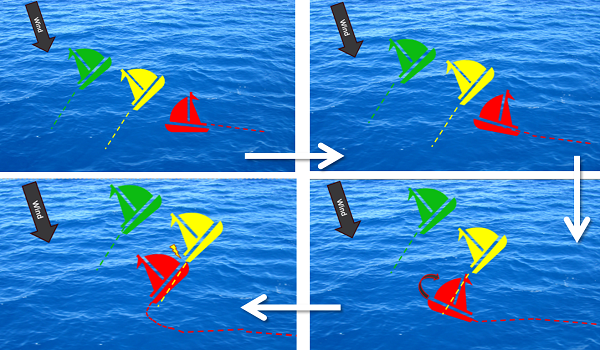My firsthand experience with the Venturi Effect had a major impact on me… literally! Although it’s technically a fluid flow principle, the term is used quite often with wind acceleration as air is squeezed through narrow spaces, such as spaces where several skyscrapers stand close to one another. I was out racing on a sailboat (the yellow one) and one of the other boats (the red one) crossed behind us. The wind funneling through our jib and mainsail created this Venturi Effect that accelerated the wind and overpowered the sail on the other boat. The captain of the other boat failed to anticipate this and rounded up into the back of our vessel, causing quite a bit of damage. Follow the white arrows below to see how this played out. Needless to say, I'm anxious for my boat to be repaired!

As with most of my articles, you might be asking yourself what in the world this had to do with Product Lifecycle Management, but you must have also realized I will at least make a valiant attempt to link the Venturi Effect and trends in the PLM software market.
The situation we currently have in the PLM space is that several factors have emerged that are beginning to create an acceleration that can either be exploited to speed your company along the productivity curve, or, if not recognized and adjusted to, could potentially drive you into the rocks of becoming non-competitive in your own markets. I will attempt to provide you with information to empower you as the captain of your own ships or perhaps navigators to successfully maneuver through these treacherous waters.
 Storm clouds have emerged in the PLM market. Obviously, cloud offerings have been available in the PLM space for some time. Arena is probably considered the pioneer as I believe they launched the first PLM offering that was “cloud only” and truly multi-tenant. Several on-premise companies offer cloud-hosted versions of their on-prem software, but that really is not a true cloud solution. Within the last couple of years, Autodesk announced Autodesk 360 which is a true multi-tenant solution and PropelPLM, a Salesforce-based solution is now in year two of their voyage into cloud-based PLM. What is new is that we are starting to see the first signs of transition from on-premise to cloud from the vendor perspective. Oracle is starting to show signs of duplicating their ERP strategy in PLM. They have shifted a significant amount of resource in both sales and technical toward their cloud offering for PLM. Unlike ERP, the cloud offering is completely different than their current on-premise PLM application AgilePLM, leaving companies forced to decide how to move forward. The positive side of this development is that cloud offerings are becoming more numerous and offer clients choices in capabilities, approaches, and platforms. The downside is that some of this is happening at the on-premise solution’s expense, which is forcing companies using on-prem solutions to start quickly assessing the future viability of their PLM platform. This returns us to the analogy: the acceleration of cloud development is like the acceleration of the wind via the Venturi Effect. How this acceleration impacts your organization depends on your circumstances and how you respond.
Storm clouds have emerged in the PLM market. Obviously, cloud offerings have been available in the PLM space for some time. Arena is probably considered the pioneer as I believe they launched the first PLM offering that was “cloud only” and truly multi-tenant. Several on-premise companies offer cloud-hosted versions of their on-prem software, but that really is not a true cloud solution. Within the last couple of years, Autodesk announced Autodesk 360 which is a true multi-tenant solution and PropelPLM, a Salesforce-based solution is now in year two of their voyage into cloud-based PLM. What is new is that we are starting to see the first signs of transition from on-premise to cloud from the vendor perspective. Oracle is starting to show signs of duplicating their ERP strategy in PLM. They have shifted a significant amount of resource in both sales and technical toward their cloud offering for PLM. Unlike ERP, the cloud offering is completely different than their current on-premise PLM application AgilePLM, leaving companies forced to decide how to move forward. The positive side of this development is that cloud offerings are becoming more numerous and offer clients choices in capabilities, approaches, and platforms. The downside is that some of this is happening at the on-premise solution’s expense, which is forcing companies using on-prem solutions to start quickly assessing the future viability of their PLM platform. This returns us to the analogy: the acceleration of cloud development is like the acceleration of the wind via the Venturi Effect. How this acceleration impacts your organization depends on your circumstances and how you respond.
The first decision is whether you need or should be on the cloud in the first place. Certain companies put large amounts of data in their PLM and even though we have made great strides in transmission speed and the cost of storage, it is still a factor and will usually require more cost, time, and money versus on-prem offerings. Companies that are  engineering-centric and use their PLM to manage their computer aided design (CAD) systems will have a tough time moving over without some sort of on-prem component to handle the large CAD files. Some of the cloud-based PLM vendors recognize this limitation and offer solutions to address it. We have partnered with both Oracle and Propel to offer a product called CloudState that provides integration to on-prem CAD product data management (PDM) tools from both Dassault and PTC and allows CAD data to be stored locally while publishing bill of materials (BOMs), attributes, and derivative files to cloud-based PLM. Some companies are limited by regulatory constraints like ITAR or FDA rules. There are several vendors who remain fully committed to on-prem offerings and continue to invest significant R&D dollars into their products for those companies that either cannot make the move or simply prefer on-prem PLM.
engineering-centric and use their PLM to manage their computer aided design (CAD) systems will have a tough time moving over without some sort of on-prem component to handle the large CAD files. Some of the cloud-based PLM vendors recognize this limitation and offer solutions to address it. We have partnered with both Oracle and Propel to offer a product called CloudState that provides integration to on-prem CAD product data management (PDM) tools from both Dassault and PTC and allows CAD data to be stored locally while publishing bill of materials (BOMs), attributes, and derivative files to cloud-based PLM. Some companies are limited by regulatory constraints like ITAR or FDA rules. There are several vendors who remain fully committed to on-prem offerings and continue to invest significant R&D dollars into their products for those companies that either cannot make the move or simply prefer on-prem PLM.
If cloud-based PLM is something your company wishes to pursue, there several differentiators you should consider while evaluating the market. The first consideration is single- versus multi-tenant. Check out this article by Terry Low for a deep-dive into their differences. If you discuss this with product vendors, each will have their own reasons why their method is superior. Single-tenant means that each instance of the product is fully segregated from any other. This approach is very similar to private cloud hosting which any company can do with their current on-prem solution. The main difference is that pricing for this offering is subscription-based and there are usually also charges for data overages and potentially additional testing environments. Many times, these types of solutions are being hosted at companies such as Amazon or Microsoft, but some companies like Oracle have chosen to develop their own hosting platforms. The positive for this type of offering is that you have more control over any changes that are made to your environment and you also might not be impacted by system failures as much since you are running each on a separate environment. The downside is that this approach is not as scalable as multi-tenant and improvements to the application will inevitably be deployed at a slower pace than multi-tenant. Multi-tenant solutions take full advantage of the cloud architecture which means that ultimately, they will be less expensive to maintain and will allow for improvements to be deployed more rapidly. The downside is that if you don’t want those improvements you might be out of luck. Salesforce is a good example of a successful multi-tenant offering. They have built-in tools that allow you to fully assess new functionality before you apply it to your environment. This seems to be the best of both worlds: the speed of multi-tenant enhancement combined with the control of single-tenant solutions. I am not sure if any of the current multi-tenant offerings have this capability (if you know of one, please comment below), but given Propel’s close association with Salesforce, I would assume they would be the closest to offering this type of capability.
Another consideration, and more specifically concern when moving to the cloud is your ability to mimic automations you currently have in place with your on-prem PLM. Most PLM platforms necessitate some level of customization via process extensions or scripts. These customizations can have a huge impact on productivity and ease-of-use so it is essential that having some capability to tweak your PLM easily is part of the cloud-based solution. This capability really transcends whether a solution is single- or multi-tenant and really comes down to the underlying architecture and the infrastructure that has been put in place to maintain the customizations. Most vendors will discourage this type of tweaking, claiming that their cloud offering is superior to on-prem and does not need this type of adjustment. While cloud offerings can be easier to use and have more modern user interfaces, there are still unique elements in each company’s process that would benefit from being able to provide role- and task-specific interfaces and automated scripts to eliminate tedious and time-consuming processes. Many on-prem solutions offer enhancements that support tailoring of the application for specific business needs. PTC’s Windchill has Navigate which is an extremely robust tool that allows for the creation of custom user interfaces and applications that can gather and display data from multiple applications. Oracle’s Agile PLM is well known for its robust support of process extensions and other code-based solutions that make it even faster and more powerful. We offer a framework for customization for AgilePLM called AttributeState that allows companies to better organize their custom PX’s and automations and makes them easier to maintain and alter. The downside of customization is that it becomes a burden to maintain, so companies often make the mistake of banning these tweaks when they make a big improvement to the solution. When moving to the cloud, it is important to thoroughly assess your access to the solution and what tools are available to make modifications as needed. Again, with Propel being based on Salesforce’s platform, you will find numerous capabilities available to make changes without creating a maintenance problem for the application. PTC’s cloud offerings also allow for Navigate to be leveraged, so it appears their cloud and on-prem products offer similar customization capabilities.
These customizations can have a huge impact on productivity and ease-of-use so it is essential that having some capability to tweak your PLM easily is part of the cloud-based solution. This capability really transcends whether a solution is single- or multi-tenant and really comes down to the underlying architecture and the infrastructure that has been put in place to maintain the customizations. Most vendors will discourage this type of tweaking, claiming that their cloud offering is superior to on-prem and does not need this type of adjustment. While cloud offerings can be easier to use and have more modern user interfaces, there are still unique elements in each company’s process that would benefit from being able to provide role- and task-specific interfaces and automated scripts to eliminate tedious and time-consuming processes. Many on-prem solutions offer enhancements that support tailoring of the application for specific business needs. PTC’s Windchill has Navigate which is an extremely robust tool that allows for the creation of custom user interfaces and applications that can gather and display data from multiple applications. Oracle’s Agile PLM is well known for its robust support of process extensions and other code-based solutions that make it even faster and more powerful. We offer a framework for customization for AgilePLM called AttributeState that allows companies to better organize their custom PX’s and automations and makes them easier to maintain and alter. The downside of customization is that it becomes a burden to maintain, so companies often make the mistake of banning these tweaks when they make a big improvement to the solution. When moving to the cloud, it is important to thoroughly assess your access to the solution and what tools are available to make modifications as needed. Again, with Propel being based on Salesforce’s platform, you will find numerous capabilities available to make changes without creating a maintenance problem for the application. PTC’s cloud offerings also allow for Navigate to be leveraged, so it appears their cloud and on-prem products offer similar customization capabilities.
 I have touched on a couple of considerations here when evaluating whether you should move to the cloud for PLM. Keep in mind that more and more money is being spent in this area and eventually on-premise will be at a significant disadvantage regarding capability. This shift could result in your company being at a disadvantage versus your competition. I still think most cloud-based PLM solutions are behind their on-prem brethren, but the gap is rapidly closing. It is important to anticipate the shift in the winds of the market so you are not caught off-guard and blown off-course, or worse into the rocks. I wish you smooth sailing in your future choices around PLM and we are always glad to offer our guidance and support to get you to your destination.
I have touched on a couple of considerations here when evaluating whether you should move to the cloud for PLM. Keep in mind that more and more money is being spent in this area and eventually on-premise will be at a significant disadvantage regarding capability. This shift could result in your company being at a disadvantage versus your competition. I still think most cloud-based PLM solutions are behind their on-prem brethren, but the gap is rapidly closing. It is important to anticipate the shift in the winds of the market so you are not caught off-guard and blown off-course, or worse into the rocks. I wish you smooth sailing in your future choices around PLM and we are always glad to offer our guidance and support to get you to your destination.


